When Geoff and Anne Shaw bought Follers Manor in 2006 it was a mess. The house was virtually uninhabitable and the grounds an eyesore: a jumble of tussock, weeds and builders’ rubble with a large, long-abandoned tennis court as a central feature.
Today with the house and gardens rejuvenated it is easier to understand why they bought Follers. Invisible from the road, the house sits high above the Cuckmere valley just outside Alfriston in East Sussex.
Below it to the east lies the small village of Litlington with far views of the South Downs National Park beyond.
After renovating the house, Geoff and Anne realised that they would need help with the derelict garden and turned to designer, Ian Kitson, for inspiration. His brief was simple: a garden that was colourful; that would encourage wildlife and trickiest, a garden that would vie confidently against such an impressive backdrop.
I first visited Follers on 8th June – with about three hundred other guests on a rare, open afternoon. Impressed as I was, the gardens were too busy for my anti-social tastes and taking photos was frustrating. Luckily a mutual friend (Gary, Seaford’s premier barber) arranged an introduction to Geoff and a couple of weeks later, I pulled up at 7.30 on a perfect sunny morning. The house was still sleeping when I let myself in for an intimate, almost intrusive second exploration of the garden.
From the small car-park, there is little hint of what lies before you. I padded down a path between the house and a large, handsome yew tree
to the sunken garden immediately behind the Manor.
Ian planned a sheltered, intimate seating area here and lined its sinuous curves with retaining flint walls; nicely mirroring the brick and flint of the house.
It is brightly if simply planted with penstemon, hardy geranium, phlomis and salvia with sempervivums in the planting pockets along the top of the wall. The clipped box adds further waves (there are no straight lines in the garden) and the floor is crazy paving. Who’d have thought that crazy paving could look so right?
The limestone pavement continues as a path down toward the wildlife pond.
Stipa gigantea and silvered Stipa tenuissima lead the way.
Obviously, large pools of water aren’t a natural feature on porous chalk so the pond is particularly striking; especially against that background.
A decking bridge spans the water
and continues its sweep on the far bank before dipping into the water.
This was a highlight of my visit with large dragonflies flashing about my head and newts scuttling down into the depths at my approach.
Near the pond’s edge, the elegant planting from the upper garden merges into the less formal, more natural.
I particularly liked this marginal. I will be introducing pickerel weed (Pontederia cordata) to the ponds at the Priory.
It was whilst standing on the decking that I experienced my first, painful jab of jealousy. I want to sit here in the early morning with a pot of coffee and a newspaper; distracted only by the buzz of insects and birdsong. And buttered toast.
Beyond the pond are more borders, fruit trees and plenty of old elder trees. With its plates of pale, fizzy flowers, blackberries and furrowed bark, I like elder – though many consider it a weed-tree.
At the bottom of the garden are bee-hives and my jealousy level notched up a level. I am very keen to have a couple of hives at the Priory and I’m seeking a bee-keeper to site hives on the meadow. Anyone?
I stood transfixed for several minutes just watching the to-ing and froing and the gentle hum of activity. The bees are tended by gardeners, Steve and Julia, who each work three days a week at Follers. Geoff mows and edges the lawns himself, sometimes twice a week. (I do like to know how many gardening-days maintain a garden, don’t you)?
A woodland path leads back up to the house and beyond is the flower meadow, at its peak in June.
Whilst I was snapping away, Geoff came out to introduce himself and chat. It was obvious that we weren’t standing in an ordinary wild-flower meadow.
I’ll let Geoff explain.
“We originally had the field seeded with meadow grass for the first year and I just cut some paths through it. In September 2010. garden designer Julie Toll suggested we try “pictorial landscape” mix. To use a new mix we had to kill it all anyway and rotivate it back to bare soil and that is the method required each subsequent year as it is only an annual meadow. We also have a pernicious weed called prickly lettuce which we are trying to eradicate so we use Roundup in the autumn and also again in February prior to being rotivated and re-seeded. I much prefer the results that we achieve versus the perennial meadow which we have elsewhere in the garden but which has not lived up to my original expectations.”
The meadow is undoubtedly beautiful but I baulked at twice yearly spraying with Roundup (glyphosate) over such a large area. And though I didn’t baulk at the result, I won’t be spraying my perennial flower and grass meadow. Weeds and all.
Do I think Ian Kitson fulfilled his brief? Well, the garden is certainly very colourful, fresh and exciting. Tick. As you might expect, the pond-on-chalk is a draw for all kinds of wildlife, as are all those trees and flowers. Tick. And for a young garden, it sits remarkably assured and at ease within an ancient landscape. Tick. To pull off all three requirements so successfully is quite a feat, Mr Kitson.
I’m afraid that Follers Manor isn’t open to the public again until next year (other than to groups of 20 or more). For more details of the garden and for 2015 open days (not yet published) see the Shaw’s WEBSITE. You might also want to visit Ian Kitson’s WEBSITE. You’ll find a link to a Gardener’s World interview with Ian talking about Follers, as well as plans of the garden and some ‘before’ photos (including the horrible tennis court).
(Follers Manor featured in the Channel 4 programme ‘Landscape Man’ which charted the making of the garden. You can watch it on YouTube – HERE).



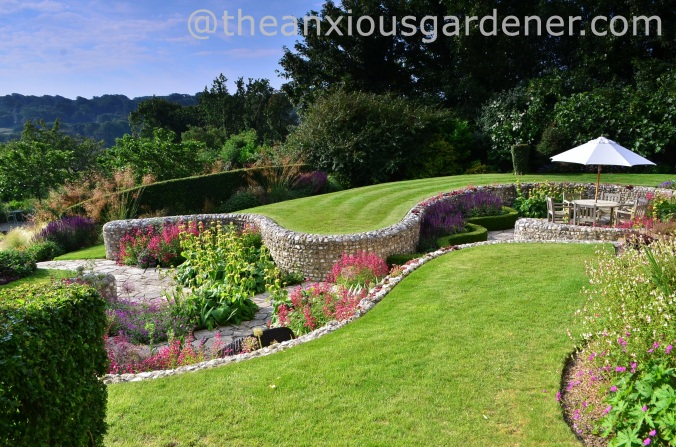




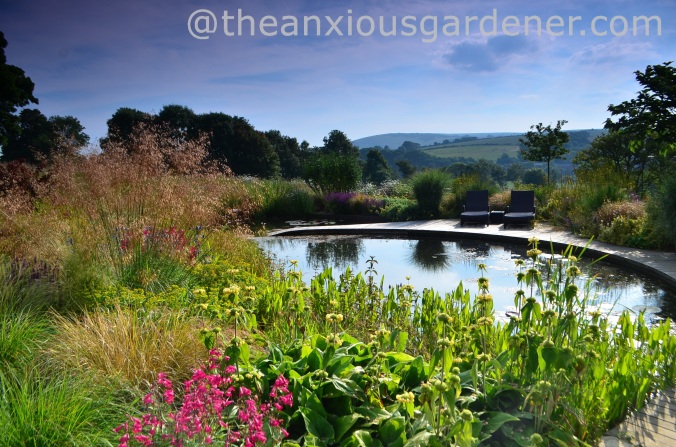




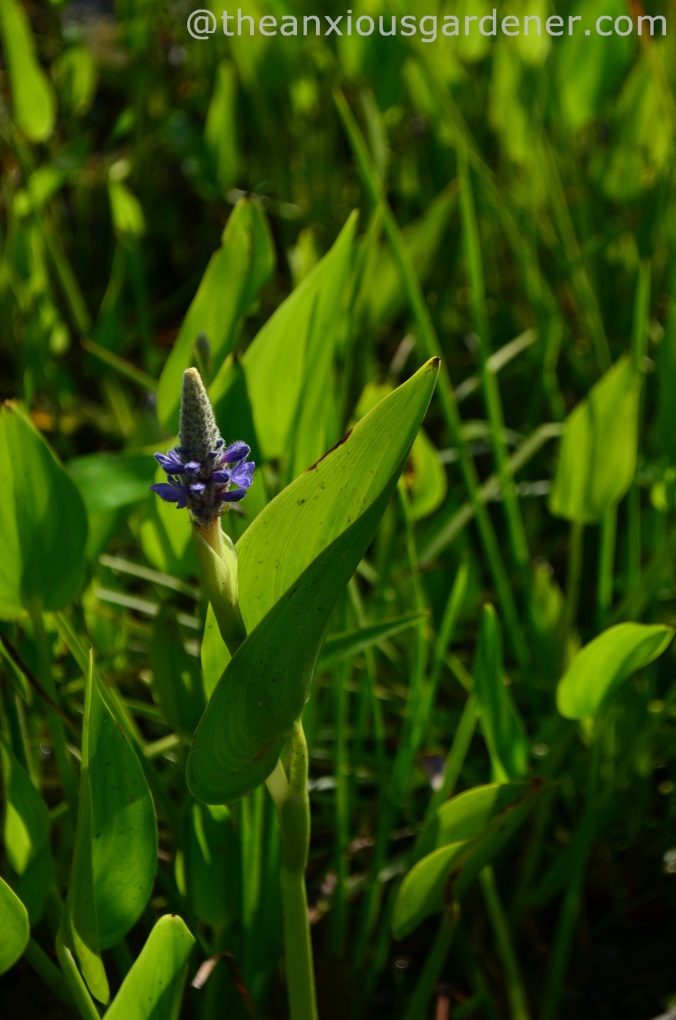

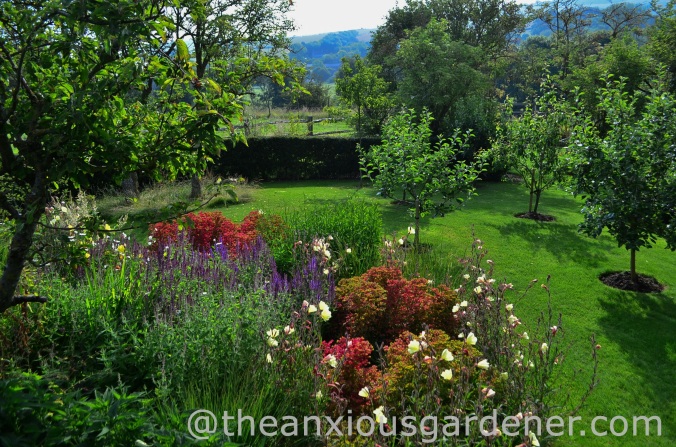
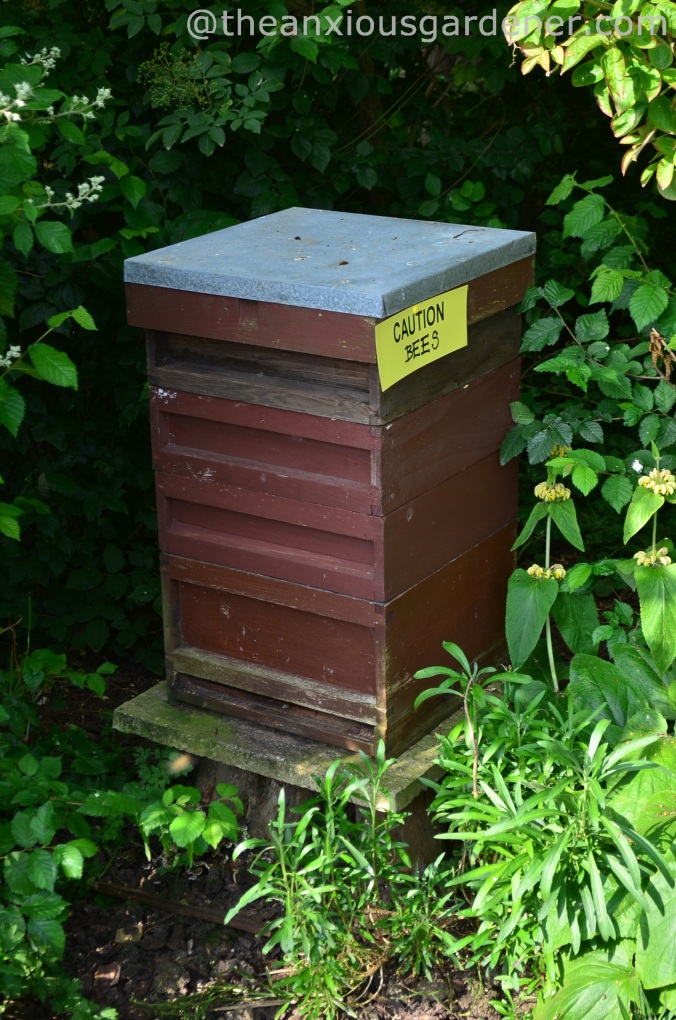







A beautiful garden, particularly bathed in that early morning light: you really captured its magic. The pictorial meadow is lovely, and I have huge envy of those swathes of purple salvias. I have tried two S. nemorosa Caradonna here now and neither lingered through the winter, nor did my cuttings take, alas…
LikeLike
Hi Sara, the salvia is impressive and not one I’ve tried to grow. But other than being on chalk, I’d have thought your conditions aren’t so very dissimilar from Follers? The light was good that day but it is fleeting – hence, the early start. Dave
LikeLike
Beautiful garden tour — thank you! I do appreciate the way you can analyze a garden’s success in meeting the terms of its creation — too many garden writers go all “immutable bonds with nature” instead of thinking hard about a Why and How of a garden. (As soon as I come across the word “communion” in a garden book is when I stop reading.) Thank you for your writing. It is clear and un-sentimental and still full of joy and even, dare I say it, poetry — thank you for the “buttered toast”. Perfect.
Is the sunken garden a micro-climate? I also went to the Shaw’s website and now I (being American) want to know about the power that Steve has over visiting Americans. Must be his English accent when he speaks Botanical Latin.
LikeLike
Hello Vivian, thank you. I’ve made a note not to use either “immutable bonds with nature” nor “communion” – and double-underlined it. If there is a micro-climate in the sunken garden, it wasn’t intentional. But it is hot and dry – in full sun with heat bounced back and forth by the walls, and sheltered from the wind too. I haven’t met Steve, I’m afraid and so can’t reveal what his especial charm for American visitors might be. You’ll need to visit in order to find out what it is! Dave
LikeLike
What a stunning garden. I’m sure I saw that on the Channel 4 programme ‘Landscape Man’ with Matthew Wilson when it was actually being designed. I remember the flint walls in the garden. It’s nice to see it and how it has established, and so brilliant that you could get in to have a nosey around on your own. A friend of mine is a garden photographer and he gets to shoot gardens early on a morning and in the evening when there’s no one else around. I’m not jealous at all. 😉 Lou
LikeLike
Hi Lou, I finally watched the ‘Landscape Man’ last night – interesting to see the garden before any work was done and how the plans evolved and then drastically scaled back because of an initial cost of £400k!!! It was very kind of Geoff to allow me unfettered access to the garden. I wouldn’t like a photographer snooping around the Priory without my guiding hand on his/her back. Dave
LikeLike
Wow those are some nice photographs! I love the meadow, and since I’m surrounded by a roundup nation the annual spraying doesn’t bother me as much…. although no spraying would seem much preferred. I wonder if no-spray is a goal for some day when the weed-seed bank dwindles.
The light on the grasses is great and I could go for a coffee out there too… and wouldn’t even need the newspaper. Lucky you to get out there on a less hectic day.
Colorful it is. Strange thing though. We moved in here around 2006 and our own efforts haven’t paid off nearly as well. Plus our one bathroom is still nearly uninhabitable with its bright baby blue tilework.
Frank
LikeLike
I don’t suppose the weed-seed bank will ever dwindle, Frank. After all, a pretty flowering plant in a meadow usually becomes a weed when growing up through a crack in the paving doesn’t it? And if you wait long enough perhaps baby-blue tiles will be back in fashion? Dave
LikeLike
I did enjoy my private viewing via your camera and comments. I love the sunken garden and the way the stone has been used. I am impressed that the designer has got such fast results because it looks a much more mature garden. Amelia
LikeLike
My camera’s autofocus was playing up that day, Amelia so I’m pleased the photos came out OK. I wanted to get there early before the light got too harsh. Dave
LikeLike
The pond, the poppies, flint retaining walls, love ’em! A stunning garden!
LikeLike
Well boys, if you’re down this way next summer …..
LikeLike
what a lovely house and garden !! I love that sunken garden especially !!!!
LikeLike
Everyone seems to love the sunken garden, Gwennie.
LikeLike
Reblogged this on Old School Garden.
LikeLike
Thanks for that Nigel.
LikeLike
You’re welcome 🙂
LikeLike
Very interesting post! I can see why you wanted a second, more private visit. Equally, I would be uncomfortable with Roundup being sprayed anywhere on my property….
LikeLike
I was going to go back for a third visit as there were a couple of shots I missed – one of the ‘bridge’ especially but I didn’t have time. Pleased you liked the tour. Dave
LikeLike
shame you couldn’t make it for that third visit…
LikeLiked by 1 person
I especially love the sunken garden and the pond with the decking bridge, beautiful!
LikeLike
Hi Dan, glad you liked it. I loved the grass combination leading down to the pond and will buy some Stipa tenuissima to go with my S. gigantea. Dave
LikeLike
I remember seeing the Landscape Man programme on this garden. Good to see it filled out.
LikeLike
I did try and watch the programme on 4oD but it didn’t seem to be live. Geoff pointed out that it is viewable on Youtube so I shall watch it this evening. Dave
LikeLike
I do feel sad about that annual meadow because old pasture is so much more valuable and quite as beautiful. (as well as easier and less chemical to maintain). But I gather that they have old meadow elsewhere and it’s problematic? Why’s that?
LikeLike
I’m not sure it is problematic, Anne (?). Geoff just prefers the look of the annual flower mix – it’s the one used at the London Olympic Park in 2012 – rather than mown paths through grass-meadow. But personally I agree with you. Dave
LikeLike
Quote “But personally I agree with you”Unquote – So do I – the twice yearly application of glyphosphate is definitely not a thing I would force on my ground. Otherwise beautiful how you present this exceptional garden, words pictures and all. Thank you! Zyriacus..
LikeLike
Thanks Zyriacus. I didn’t want to come across as overly critical. Geoff and Anne have done a remarkable job and I was very impressed by Follers. Who am I to overly criticise something I personally don’t agree with. But then it seemed wrong not to mention it either. Dave
LikeLike
Stunning…thanks for the virtual walk round….I always want to start my garden again when I see something inspiring like this…..but I don’t think my bones would take such a big task …oh well I will just dream… 🙂
LikeLike
Hi Sue, my own garden needs a complete makeover – we’ve barely touched it since moving in. My only excuse is that it might be a building site one day – but I won’t be doing a virtual tour of it any time soon. Dave
LikeLike
🙂
LikeLike
I love the design of the garden, the paths that were constructed to take you through the plantings is so much fun. I love the eye pleasing detailed that was planned into it. I love looking at the photos they are so full of ideas and inspirations, I am so pleased you went back for a second visit.
LikeLike
Hi Charlie, sorry your comments went to my spam folder – no idea why. Glad you liked the garden – it is quite special I think. Dave
LikeLike
Oh you lucky, lucky man, I am positively green with jealousy. How perfect to have been able to see it solo, in the early morning. I saw a programme about this garden a while ago and fell in love with then, in its raw, just-made state, particularly the snaking sunken seating are come path and the way it sweeps down to that pond. Utterly magical. But I am with you on the twice-yearly glysophating, seems a little too high maintenance to moi, and somehow contradicts everything I think a meadow is about, i.e. natural wildness. Weeds and all. But I wouldn’t complain if someone wanted me to move in. Actually I would, I couldn’t live inland again now, but you get my drift. Mainly green.
LikeLike
I have yet to watch the programme, Janet but I’m looking forward to it. There is a glorious view of the sea about a minutes drive from Follers at nicely named High and Over. Great panorama over Cuckmere Haven, Seaford and the Seven Sisters but I know what you mean. Litlington is some compensation, it’s a beautiful little village with the nicest possible tea gardens and smashing small independent nursery. And good pub too. But I’m not going to change your mind am I, eh? Dave
LikeLike
Wow, wow, wow, wow, wow – have you gathered that I love this garden – I wonder how much Mr. Kitson would charge to come and do a makeover in my garden.
LikeLike
That’s a lot of wow’s, Elaine. And I wonder too. Dave
LikeLike
What a wonderful post. thank you for taking the time to both show and tell us about it. And I so understand this very frank statement: ‘It was whilst standing on the decking that I experienced my first, painful jab of jealousy. I wanted to sit here in the early morning with a pot of coffee and a newspaper; distracted only by the buzz of insects and birdsong. And buttered toast.”
Looking at these pictures, I completely understand!
LikeLike
Hello Cynthia, the painful jab was possibly also a stab of hunger, truth be told. I went before breakfast. Glad you liked the post. Dave
LikeLike
Oh, what a beautiful place — and how lovingly you’ve photographed it! I love the shape of the sunken garden and how it broadens out into that wonderful puddle of flowers near the lower end. And I like the long swathes of a single kind of flower/plant. I often look at the perpetual changes in mixed borders and think, “What brought that on?” Odd how meadows with their more genuinely random mixture of blooms never seem incoherent like a planned border can.
P.S. Buttered toast might be an enhancement, not a distraction. Experiments should be held.
LikeLike
It is a lovely garden especially as I didn’t have to share it with anyone. And yes, I’ve often thought about ‘random’ planting when looking at the natural spacing of anemones or primroses or something similar. Fiendishly difficult to recreate unless you’re scattering a seed mix about, I suppose. My scattered daffodil bulbs never seem as ‘natural’ as I would like. (You’re right of course about buttered toast but sometimes it is probably both an enhanced distraction and a distracting enhancement). Dave
LikeLike